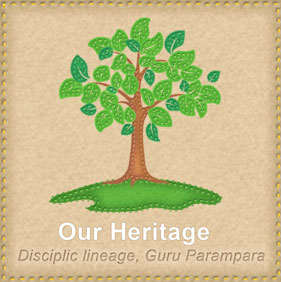Murwillambah, Australia: April, 26, 2005
Sri Srimad Bhaktivedanta Narayana Maharaja
[The following talk was a prelude to the series of classes Srila Narayana Maharaja gave on Raya Ramananda Samvada in Murwillumbah, Australia, the first city of his official 2005 summer preaching tour, and it took place in one of his disciples' homes.]
I want to tell something in brief. A human being must have a goal of life. If you have no goal of life you are an animal – not only an animal but a foolish animal – a donkey. It is not I who am telling you this; our scriptures are telling it. Make an aim and object of your life. In ordinary life we choose an occupation. We consider, “Should I be a doctor, should I be an engineer, should I be this or that?” Then we proceed.
Lord Sri Krsna is very merciful. He has given His mercy without any cause or reason by placing us in this human body, the body that is just suitable for becoming a devotee. We want to be happy in this world, but there is no happiness for anyone except devotees. There is also no happiness for a third-class devotee; one must be an uttama-adhikari. The madhyama-adhikari struggles, but the uttama-adhikari can reconcile all matters and always be happy – like Sri Sukadeva Gosvami.
The material body is a bag of urine, stool, blood and so many other abominable things. We should know that anything we try to do by this body, like being healthy, wealthy and very happy, cannot be successful in the end. If you are now young, you may seem to be happy. Some happiness may be there, but very soon it will transfer into suffering. Your body will become old and after some time all its beauty will go. Happiness will go and so many diseases will come. Even doctors will not be able to help you. Then, at the time of death, whatever you have collected by this body, such as wife, children and wealth, cannot be taken with you.
Pure devotion to the Supreme Lord has been elaborately discussed in the Srimad-bhagavatam, the Vedas and the Upanisads. Svetasvatara Upanisad states:
yasya deve para bhakti
yatha deve tatha gurau
tasyaite kathita hy arthah
prakasante mahatmanah
[“Only unto those great souls who have implicit faith in both the Lord and the spiritual master are all the imports of Vedic knowledge automatically revealed.”
Yasa deve para-bhakti – what is para-bhakti? It is the prema-bhakti, the development of bhakti up to gopi-bhava. In Srimad-bhagavatam, Sri Caitanya-caritamrta, and in the books of our Gosvamis it has been said:
dharmah projjhita-kaitavo ’tra paramo nirmatsaranam satam
vedyam vastavam atra vastu sivadam tapa-trayonmulanam
srimad-bhagavate maha-muni-krte kim va parair isvarah
sadyo hrdy avarudhyate ’tra krtibhih susrusubhis tat-ksanat
[Completely rejecting all religious activities which are materially motivated, this Bhagavata Purana propounds the highest truth, which is understandable by those devotees who are fully pure in heart. The highest truth is reality distinguished from illusion for the welfare of all. Such truth uproots the threefold miseries. This beautiful Bhagavatam, compiled by the great sage Vyasadeva [in his maturity], is sufficient in itself for God realization. What is the need of any other scripture? As soon as one attentively and submissively hears the message of Bhagavatam, by this culture of knowledge the Supreme Lord is established within his heart. (Srimad-bhagavatam 1.1.2)]
Srimad-bhagavatam has revealed the real parama-dharma (supreme religious principle) of the living entity:
nigama-kalpa-taror galitam phalam
suka-mukhad amrta-drava-samyutam
pibata bhagavatam rasam alayam
muhur aho rasika bhuvi bhavukah
[“O expert and thoughtful men, relish Srimad-Bhagavatam, the mature fruit of the desire tree of Vedic literatures. It emanated from the lips of Sri Sukadeva Gosvami. Therefore this fruit has become even more tasteful, although its nectarean juice was already relishable for all, including liberated souls.” (Srimad-bhagavatam 1.1.3)]
The explanation of the essence of all nigama, that is, the instructions of Vedas, Upanisads, Puranas and so on was given personally by Sri Vyasa in Srimad-bhagavatam and it is told here in this verse. Srimad-bhagavatam consists only of rasa (transcendental mellow taste, as in a most tasteful fruit). That rasa was situation in Goloka Vrndavana. Sri Sukadeva Gosvami went there in the form of the parrot Suka and, by tasting that fruit with his beak, that nectar became more nectarian. By the medium of our guru-parampara, that fruit then came to Earth, and we should try to taste it.
Srila Vyasa compiled the Vedas and then divided it into four parts, and in them he gave so many important instructions. He compiled Brahma-sutra, Mahabharata and many other authorized Vedic literatures, but he was not happy. In the meantime his guru Narada Muni came and told him, “You have composed all the Vedic scriptures, so why do you look unhappy?"
Srila Vyasadeva replied, “Oh Gurudeva, I don’t know.”
Narada said, “You have given importance to kama (sense gratification), artha (economic development), dharma (mundane religiosity) and moksa (impersonal liberation), but you have not written about the sweet pastimes of Lord Sri Krsna. Have you written how Mother Yasoda bound that Supreme Lord?
"No, I know nothing about that."
"Have you written that Sri Krsna placed His flute and peacock feather at the lotus feet of Srimati Radhika and told Her, ‘I cannot repay your love and affection.’ Have you written Gopi-gita, Bhramara-gita and other such topics?"
"No, I don't know these topics."
Sri Narada said finally, "You should meditate, and then all these topics will enter your heart.”
Service to Sri Krsna in the same manner that the gopis serve Him – this is the main object of our life. If you read Raya Ramananda Samvad, you can know these truths. There, Srila Raya Ramananda told Sri Caitanya Mahaprabhu that prema-bhakti is best, and to explain the process to achieve it he said:
krsna-bhakti-rasa-bhavita matih
kriyatam yadi kuto ’pi labhyate
tatra laulyam api mulyam ekalam
janma-koti sukrtair na labhyate
[“Pure devotional service in Krsna consciousness cannot be had even by pious activity in hundreds and thousands of lives. It can be attained only by paying one price – that is, intense greed to obtain it. If it is available somewhere, one must purchase it without delay.” (Caitanya-caritamrta Madhya-lila 8.70)]
This is raganuga-bhakti. If there is a great desire and mood to serve Krsna with love and affection, then vraja-bhakti can be achieved.
Raya Ramananda gradually discussed dasya-rasa, sakhya-rasa and vatsalya-rasa, but Sri Caitanya Mahaprabhu was not fully satisfied. He said, “I want to hear more”, and Raya Ramananda began to talk about madhurya-prema, and Sri Caitanya Mahaprabhu then said, “This is certainly the highest, but I still want to hear more.” Raya Ramananda then said, “In this world I have never heard or known of anyone asking this question: 'What is after this?" ” Mahaprabhu wanted him to tell about the gopi-prema in the heart of Srimati Radhika.
Prema-bhakti is of two kinds: one is sambhandatmika, the loving service of associates like Nanda Baba in the parental mood, those in the mood of friends and servants. The second kind is kamatmika (madhurya-rasa) What is kamatmika? It is the mood of a paramour, the prema-bhakti of the gopis. This is also of two kinds: sambhoga-mayi (a direct amorous relationship with Krsna) and tat-tad bhava icchamayi (the desire to experience Srimati Radhika's sweet bhavas.) Tat-tad bhava icchamayi is the very highest achievement for the living entity. I am telling this so you will know the goal of your life. You cannot imagine the height of its elevated nature, and actually there is no equivalent English word for it, but still I am telling you something about it.
Sambhogatmika is the loving service of Krsna's associates like Lalita and Visakha. Tat-tad-bhava icchamayi is the service of the manjaris, who are headed by Sri Rupa Manjari. If Srimati Radhika is happy, Rupa Manjari is happy. If Srimati Radhika laments, Rupa Manjari laments.
Sometimes Lalita, Visakha and others like them, although superior in rank to the manjaris, approach Rupa Manjari, Rati Manjari and Lavanga Manjari and ask, “May I come into the kunja now?” Rupa Manjari and other manjaris have some special secret services. They can always be present during Sri Krsna's most confidential pastimes with Radhika, but Lalita and Vishaka cannot. They have to get permission from these "gatekeepers."
In Sri Caitanya-caritamrta it is written:
anarpita-carim cirat karunayavatirnah kalau
samarpayitum unnatojjvala-rasam sva-bhakti-sriyam
harih purata-sundara-dyuti-kadamba-sandipitah
sada hrdaya-kandare sphuratu vah saci-nandanah
["May the Supreme Lord who is known as the son of Srimati Saci-devi be transcendentally situated in the innermost chambers of your heart. Resplendent with the radiance of molten gold, He has appeared in the Age of Kali by His causeless mercy to bestow what no incarnation has ever offered before: the most sublime and radiant mellow of devotional service, the mellow of conjugal love." (Caitanya-caritamrta Adi-lila 1.4)]
Sri Caitanya Mahaprabhu is Lord Sri Krsna Himself, having taken the mood and complexion of Srimati Radhika, and he came to give unnatojjvala-rasam sva-bhakti-sriyam. He did not come to give unnatojvala-rasa, the mood of Radhika, Lalita or Visakha. That mood is reserved for them. Krsna came in the form of Caitanya Mahaprabhu, appearing in the womb of Sacimaiya, to give the beauty of unnatojvala rasa. What is that beauty? It is manjari-bhava (also known as bhava-ullasa-rati) (*See endnote 1)
Another two verses have been told in this connection:
radha krsna-pranaya-vikrtir hladini saktir asmad
ekatmanav api bhuvi pura deha-bhedam gatau tau
caitanyakhyam prakatam adhuna tad-dvayam caikyam aptam
radha-bhava-dyuti-suvalitam naumi krsna-svarupam
[The loving affairs of Sri Radha and Krsna are transcendental manifestations of the Lord’s internal pleasure-giving potency. Although Radha and Krsna are one in Their identity, They separated Themselves eternally. Now these two transcendental identities have again united, in the form of Sri Krsna Caitanya. I bow down to Him, who has manifested Himself with the sentiment and complexion of Srimati Radharani although He is Krsna Himself. (Caitanya-caritamrta Adi-lila 1.5)]
sri-radhayah pranaya-mahima kidrso vanayaiva-
svadyo yenadbhuta-madhurima kidrso va madiyah
saukhyam casya mad-anubhavatah kidrsam veti lobhat
tad-bhavadhyah samajani saci-garbha-sindhau harinduh
[Desiring to understand the glory of Radharani’s love, the wonderful qualities in Him that She alone relishes through Her love, and the happiness She feels when She realizes the sweetness of His love, the Supreme Lord Hari, richly endowed with Her emotions, appeared from the womb of Srimati Saci-devi, as the moon appeared from the ocean. (Caitanya-caritamrta Adi-lila 1.6)]
Lord Sri Krsna personally came to taste all the varieties of moods of Srimati Radhika – madana (Her highest moods of meeting and separation combined) and also modan (Her mood of meeting). He also has no modana, so He has something to gain in that connection as well. We are not going to discuss madana, modana or the gopis' moods now – only the beauty of the gopis' moods, which Sri Caitanya Mahaprabhu came to give. Our aim and object is to be under the guidance of Rupa Manjari and to serve Sri Sri Radha and Krsna.
This is the highest mood possible for the jiva, but we should not imitate it or blindly follow. We will have to wait, and begin from vaidhi-bhakti. It is stated in Srimad Bhagavatam:
sravanam kirtanam visnoh
smaranam pada-sevanam
arcanam vandanam dasyam
sakhyam atma-nivedanam
[Hearing and chanting about the transcendental holy name, form, qualities, paraphernalia and pastimes of Lord Visnu, remembering them, serving the lotus feet of the Lord, offering the Lord respectful worship with sixteen types of paraphernalia, offering prayers to the Lord, becoming His servant, considering the Lord one’s best friend, and surrendering everything unto Him (in other words, serving Him with the body, mind and words)—these nine processes are accepted as pure devotional service. (Srimad-bhagavatam 7.5.23)]
In this connection Srila Rupa Gosvami has written:
adau sraddha tatah sadhu-
sango 'tha bhajana-kriya
tato 'nartha-nivrttih syat
tato nistha rucis tatah
athasaktis tato bhavas
["In the beginning one must have a preliminary desire for self-realization. This will bring one to the stage of trying to associate with persons who are spiritually elevated. In the next stage one becomes initiated by an elevated spiritual master, and under his instruction the neophyte devotee begins the process of devotional service. By execution of devotional service under the guidance of the spiritual master, one becomes free from all material attachment, attains steadiness in self-realization, and acquires a taste for hearing about the Supreme Personality of Godhead, Sri Krsna. This taste leads one further forward to attachment for Krsna consciousness." (Bhakti-rasamrta-sindhu 1.4.15-16)]
When attachment (asakti) to Krsna matures, then bhava-bhakti manifests:
suddha-sattva-visesatma
prema-suryamsu-samya-bhak
rucibhis citta-masrnya-
krd asau bhava ucyate
[“‘When devotional service is executed on the transcendental platform of pure goodness, it is like a sun-ray of love for Krsna. At such a time, devotional service causes the heart to be softened by various tastes, and one is then situated in bhava [emotion].’ (Caitanya-caritamrta Madya-lila 23.5]
Bhava is the semblance, or the first stage, of prema. After you reach the stage of prema in Goloka Vrndavana, your prema will increase to the stages of sneha, maan, pranaya, raga, anuraga and bhava, and finally to mahabhava.*(see endnote 2)
Srila Vyasadeva and Sri Sukadeva Gosvami told about the sweet pastimes of Sri Krsna, from top to bottom, in the 10th canto of Srimad-bhagavatam. Then, in the 11th canto they taught the process to realize those pastimes. In Caitanya-caritamrta also, Krsnadasa Kaviraja Gosvami first revealed the aim and object of life. Then at last, in Raya Ramananda Samvad, when Sri Caitanya Mahaprabhu heard Raya Ramananda's conclusion that Srimati Radhika's madhurya-rasa as the highest goal and He fully accepted that, He then asked how one can achieve it. Raya Ramananda replied that without being under the guidance of the gopis and following their footsteps one cannot attain the direct service of Sri Sri Radha and Krsna.
Even Laksmi tried, and tried and tried, but she failed. The Dvijapatnis (the wives of the brahmanas) came to Sri Krsna in the forest and told Him, "We will return home. We will serve You here." Krsna assured them, "Go now, and in your next birth you may be gopis." The Dandakaranya sages and the Sruti-caris (personified Vedas) also followed in the footsteps of the gopis, and they also later on took birth as gopis.
I have told this in brief and I have explained to you the elevated goal, but begin from sraddha, faith. (*see endnote 3)
If you have some bhakti but no sadhu-sanga, your bhakti will decrease. I have seen so many who left sadhu-sanga and thus became weak, weaker and weakest. If you think, “Only I am a sadhu; what is the use of other sadhus?" this means you are unfortunate. Some sannyasis thought like this and they left sadhu-sanga, and then they became householders. Moreover, they turned against Lord Krsna.
Try to realize all these truths and begin from sraddha. Engage in sravanam and kirtanam, hearing and chanting about Lord Sri Krsna, and always give importance to sadhu-sanga. This will increase and develop your bhakti. Without this, your bhakti will disappear.
Gaura premanande.
[*Endnote 1: bhava-ullasa rati – Generally, devotees of the same mood and who are enriched with similar desires naturally share suhrd-bhava, intimate friendship, with each other. That is why the love and affection that Lalita and the other sakhis have for Srimati Radhika is called suhrd-rati. When their suhrd-rati is the same as or slightly less than their Krsna-rati (affection towards Sri Krsna), this is called sancari-bhava (a temporary emotion that is compared to the waves that swell and then return to the ocean of their permanent emotion of the mood of Krsna's beloveds). In other words when this suhrd-rati becomes equal to the waves in the ocean of their prominent affection for Krsna, it is a sancari-bhava. However, in the case of the manjari-sakhis, their suhrd-rati (for Sri Radha and everything connected with Her), which abundantly exceeds their krsna-rati and which constantly increases by the moment due to their full absorption in it, is called bhava-ullasa-rati. This is a special feature of madhura-rasa. Of the five types of sakhis, only the nitya sakhis and prana sakhis, who are known as manjaris, have this bhava-ullasa-rati as their permanent emotions (sthayi-rati). It is no longer just a sancari-bhava. These manjaris nurture an abundance of sneha, tender affection, for Radhaji.
It is seen that creepers are always endeavoring to embrace trees, but the leaves, flowers and buds (manjaris) of the creepers do not even slightly try to embrace the trees directly. When a creeper embraces a tree, the joy of those flowers, leaves, and manjaris automatically increases. In Sri Vrndavana Srimati Radhika stands supreme among all gopis. She is famous as the kalpa-lata (the creeper that fulfills every desire) of love for Sri Krsna. Some of Her sakhis have the nature of leaves, some are like flowers, and some like manjaris. That is why they are always eager for Srimati Radhika to meet with Krsna, and are carried away by the bliss of Their union. (Srila Narayana Maharaja's commentary on Venu-gita, verse 7)
Endnote 2: sneha – that stage when prema, attaining a state of excellence, intensifies one's perception of the object of love and melts the heart. When sneha is enkindled in the heart, there is no quenching of the ever-new thirst for seeing the beloved.
Maan – that stage of prema in which sneha reaches exultation, thus causing one to experience the sweetness of the beloved in ever new varieties (Ujjvala-nilamani 14.96), and when the nayika assumes an outward demeanor of pique which turns into transcendental anger and indignation arising out of jealous love.
Pranaya – that intensified stage of prema when maan assumes a feature of unrestrained intimacy known as visrambha, or confidence devoid of any restraint or formality. This confidence causes one to consider one's life, mind, intelligence, body, and possessions to be one in all respects with the life, mind, intelligence, and body of the beloved.
Raga – 1) an intensified stage of prema in which an unquenchable loving thirst (prema-mayi trsna) for the object of one's affection (Sri Krsna) gives rise to spontaneous and intense absorption in one's beloved, so much so that in the absence of the opportunity to please the beloved, one is on the verge of giving up his life; 2) when pranaya is experienced in the heart as immense pleasure. If by accepting some misery there is a chance to meet with Krsna, then that misery becomes a source of great happiness. And where happiness affords no opportunity to meet with Krsna, that happiness becomes the source of great distress.
anuraga – an intensified stage of prema as defined in Ujjvala-nilamani (14.146): "Although one regularly meets with and is well-acquainted with the beloved, the ever-fresh sentiment of intense attachment causes the beloved to be newly experienced at every moment, as if one has never before had any experience of such a person."
bhava – 1) loving emotions; a particular mood of love in which the devotee serves Krsna. 2) an intensified stage of prema which in Ujjvala-nilamani has been equated with maha-bhava, which occurs when anuraga attains a certain stage of exhilaration and relish. This can be experienced and relished only by anuraga itself and by no other bhava. When anuraga is adorned with the inflamed and exciting sattvika passions like molten gold and reaches its climax in Srimati Radhika, becoming identical with Her very temperament and dispositions, it is called bhava.
mahabhava – the most mature stage of prema.
Endnote 3: “Sraddha is confident, firm faith that by rendering transcendental loving service to Krsna one automatically performs all subsidiary activities. Such faith is favorable to the discharge of devotional service." (Caitanya-caritamrta Madhya-lila 22.62)
Editor: Syamarani dasi
Transcriber and Typist: Vasanti dasi









